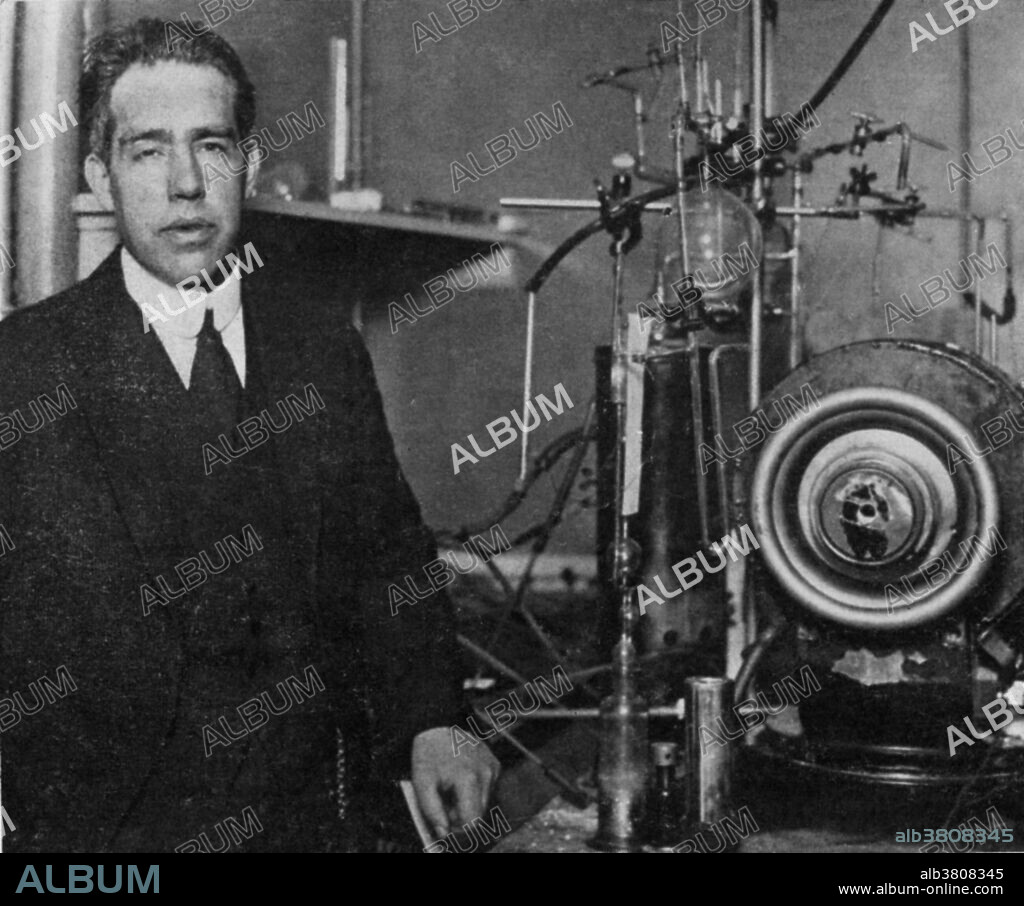alb3808345
Niels Bohr, Danish Physicist

|
Añadir a otro lightbox |
|
Añadir a otro lightbox |



¿Ya tienes cuenta? Iniciar sesión
¿No tienes cuenta? Regístrate
Compra esta imagen.
Selecciona el uso:

Título:
Niels Bohr, Danish Physicist
Descripción:
Traducción automática: Bohr junto a un imán y un aparato de descarga de gas que utilizó para estudiar las propiedades de los átomos en los gases, 1922. Niels Henrik David Bohr (7 de octubre de 1885 - 18 de noviembre de 1962) fue un físico danés que realizó contribuciones fundamentales para comprender la estructura atómica y la mecánica cuántica, por lo que recibió el Premio Nobel de Física en 1922. Bohr publicó su modelo de estructura atómica en 1913, en el que introdujo la teoría de los electrones que viajan en órbitas alrededor del núcleo del átomo, y las propiedades químicas de cada elemento están determinadas en gran medida por el número de electrones en las órbitas externas de sus átomos. También introdujo la idea de que un electrón podría caer de una órbita de mayor energía a una de menor, emitiendo en el proceso un fotón (cuanto de luz) de energía discreta. Esto se convirtió en una base para la teoría cuántica. Bohr fue mentor y colaboró con muchos de los mejores físicos del siglo en su instituto de Copenhague. Formó parte del equipo británico de físicos que trabajaba en el Proyecto Manhattan, donde se le conocía con el nombre de Nicholas Baker por razones de seguridad. Su papel en el proyecto era el de consultor. Después de la guerra, Bohr regresó a Copenhague, donde murió en 1962 de un paro cardíaco.
Bohr beside a magnet and gas-discharge apparatus he used to study the properties of atoms in gases, 1922. Niels Henrik David Bohr (October 7, 1885 - November 18, 1962) was a Danish physicist who made foundational contributions to understanding atomic structure and quantum mechanics, for which he received the Nobel Prize in Physics in 1922. Bohr published his model of atomic structure in 1913 wherein he introduced the theory of electrons traveling in orbits around the atom's nucleus, the chemical properties of each element being largely determined by the number of electrons in the outer orbits of its atoms. He also introduced the idea that an electron could drop from a higher-energy orbit to a lower one, in the process emitting a photon (light quantum) of discrete energy. This became a basis for quantum theory. Bohr mentored and collaborated with many of the top physicists of the century at his institute in Copenhagen. He was part of the British team of physicists working on the Manhattan Project where he was known by the name of Nicholas Baker for security reasons. His role on the project was as consultant. Following the war Bohr returned to Copenhagen where he died in 1962 of heart failure.
Crédito:
Album / Science Source / New York Public Library
Autorizaciones:
Modelo: No - Propiedad: No
¿Preguntas relacionadas con los derechos?
¿Preguntas relacionadas con los derechos?
Tamaño imagen:
3695 x 3079 px | 32.5 MB
Tamaño impresión:
31.3 x 26.1 cm | 12.3 x 10.3 in (300 dpi)
Palabras clave:
1885 • 1922 • 1962 • BLANCO Y NEGRO • CIENCIA • ESCANDINAVO • FAMOSA • FAMOSO • FIGURA • FÍSICA (CIENCIA) • FÍSICO (CIENTIFICO) • FOTO • FOTOGRAFIA • GANADOR DEL PREMIO NOBEL • GENTE • HISTORIA • HISTORICO • HOMBRE • HOMBRES • IMPORTANTE • MASCULINO • MECANICA CUANTICA • NIELS BOHR • PERSONA • PERSONALIDAD • PERSONALIDADES • PORTRAIT • PREMIO NOBEL • RETRATO DE HOMBRE • RETRATO • S. XX • SIGLO XX • TEORIA CUANTICA
 Pinterest
Pinterest Twitter
Twitter Facebook
Facebook Copiar enlace
Copiar enlace Email
Email
